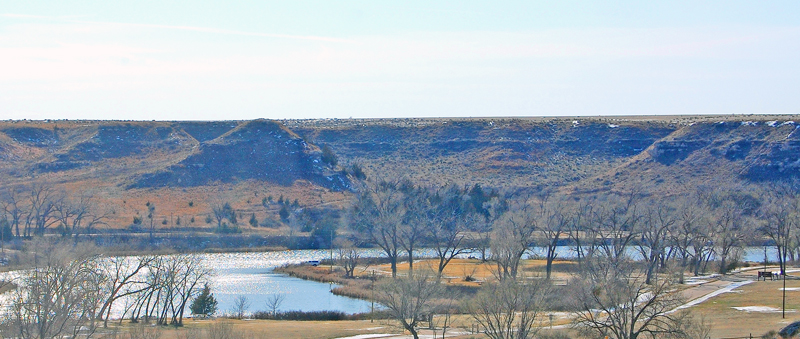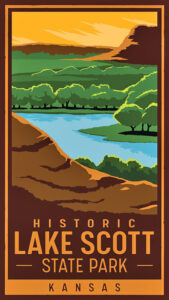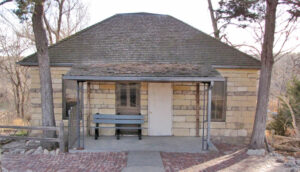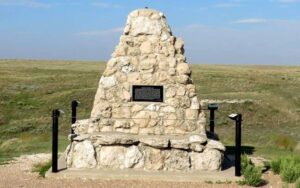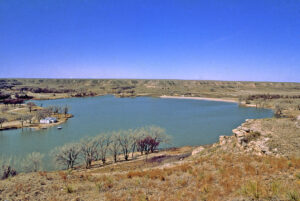Lake Scott State Park & Wildlife Area is a 1,280-acre Kansas state park in Scott County, Kansas.
The park was established in 1928 following a donation of the land by the Herbert Steele family. Scott State Park surrounds Lake Scott, a spring-fed freshwater lake.
Lake Scott State Park is the site of a ruined Taos Pueblo. The Taos Puebloans arrived in present-day western Kansas in 1664 after escaping Spanish colonial rule in New Mexico. They allied with a group of Plains Apache Indians. The Taos Indians built the protective pueblos and an irrigation system from a nearby spring to water their crops. The settlement, known as El Cuartelejo, was occupied for 20 years before the builders returned to their home territory.
The pueblo was reoccupied in 1696 by a group of Picuris Indians Indians. The Picuris were compelled to retreat to their homelands in colonial New Mexico ten years later.
A Spanish expedition used the pueblo in 1720 on a journey north and west to assess the strength of the French in the area. The expeditionary forces were attacked by a group of Pawnee Indians about 150 miles from El Cuartelejo. The Spanish considered using the structure as a frontier station, but cancelled the undertaking due to its remote location from their supplies in New Mexico. The last known settlement at the pueblo was recorded in 1727 when local Indians reported that French traders were using it. The effects of weather and erosion caused the structure to disappear, leaving just a “slight mound” and some irrigation ditches.
Herbert Steele arrived in Scott County in 1888. He established his homestead on what is now Lake Scott State Park soon after. He and his wife, Eliza Landon, lived there at first in a dugout and later built a four-room house of native sandstone. Herbert Steele discovered the ruins in 1889. Archaeologists from the University of Kansas excavated them.
The original Steele home is now a museum and displays furniture and tools used by the early settlers of Scott County.
The Steeles donated their property to the Kansas Forestry, Fish and Game Commission in 1928. The park is 1,280 acres, including the 640-acre Steele homestead.
Initially called Lake McBride, Lake Scott was one of the first areas set aside in the Kansas parks system.
In 1964, the El Cuartelejo ruins were designated a National Historic Landmark.
In 1970, the site was excavated, revealing that the pueblo was a seven-room structure, enough to house a small band of Indians. The foundations of the pueblo were reconstructed at this time and are open to the public with interpretive signs and displays. Near the pueblo, traces of shallow ditches extend from the nearby springs.
Today, Lake Scott State Park is open for year-round recreation. Canyons, Steep bluffs, and natural springs surround the 100-acre lake. There are 55 modern and 175 primitive campsites on the campgrounds, with two modern restroom facilities provided. There is a swimming beach on the lake with a playground nearby. A concessionaire sells fishing and camping supplies and also rents out canoes and pedal boats.
There are several miles of trails in the park that are open to hiking and horseback riding. The trails venture into wild areas where wildlife can be observed. Commonly seen wild animals include wild turkeys, deer, beavers, and bobcats. Public hunting is allowed on the 160 acres of the designated wildlife area west of the park. Vehicle parking is available at either end of the access road into the area. Hunters can expect rugged, wooded canyon terrain. Landowner permission is required to hunt on the nearby private land.
Lake Scott is open to fishing. Common game fish include Redear Sunfish, Green Sunfish, Crappie, Channel Catfish, Largemouth Bass, Trout, Walleye, Bluegill, and Black Bullhead. A trout permit is required to possess trout during the trout season.
Parks and public lands regulations are enforced at Historic Lake Scott State Park.
One of the most historic locations in Kansas, the park contains more than 26 documented archaeological sites. The Steele home, the dwelling of the original settlers in the area, has been preserved much as it was 100 years ago. About one mile south of the park is Battle Canyon, the location of the last Native American battle in Kansas.
Listed by National Geographic as one of the country’s 50 must-see state parks, Scott State Park is a stunning oasis of natural springs, deep wooded canyons, craggy bluffs, and early American history, hidden in a canyon in the western Kansas prairie. The 1,020-acre park surrounds the 100-acre, spring-fed Scott State Fishing Lake, and a 160-acre wildlife area lies west of the park.
Located along the Western Vistas Historic Byway, Scott State Park is about 11 miles north of Scott City, west of US-83 on K-95. The address is 101 W Scott Lake Dr., Scott City, KS 67871
©Kathy Alexander/Legends of America, November 2025.
Also See:
Sources:
Kansas Department of Wildlife & Parks
Kansas Geological Survey
Kansas Tourism
Wikipedia

